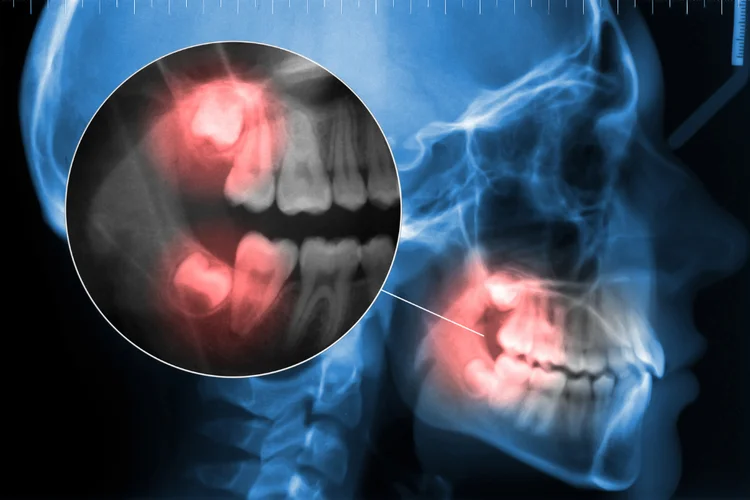The first signs of wisdom teeth coming in often include a dull ache
or pressure at the back of the mouth, accompanied by gum swelling,
tenderness, or visible white spots where the tooth begins to
emerge.
Wisdom teeth, also known as third molars, are the last set of adult teeth to
develop. While some individuals may experience a smooth eruption with
minimal discomfort, others may face issues such as crowding, gum irritation,
or complications due to limited space in the jaw.
Recognising these early signs can help you decide when to seek dental advice
and manage potential problems before they progress.

Stages of Wisdom Teeth Coming In
Wisdom teeth typically begin to erupt between the ages of 17 and 25, and their emergence can lead to a range of noticeable signs and symptoms in the mouth and jaw. The stages of eruption can be broadly described as follows:
| Stage | Description |
|---|---|
| 1. Tooth Development Beneath the Gums |
|
| 2. Initial Eruption or Breakthrough |
|
| 3. Partial Eruption with Possible Complications |
|
| 4. Full Eruption or Impaction |
|
WhatsApp Us Now
Signs & Symptoms of Wisdom Teeth Coming In
1. Mild Discomfort or Pain at the Back of the Mouth
One of the earliest and most common signs of wisdom teeth coming in is a
dull ache or mild pain behind your molars.
This discomfort often starts gradually and may feel like pressure or
tenderness in the gums at the back of your mouth. The sensation may come and
go at first, becoming more noticeable as the tooth pushes through the gum
line. You may feel it more when chewing or brushing in that area.
If you're looking for ways to manage this discomfort at home, read our guide to wisdom tooth
pain relief for practical tips and advice.

2. Redness and Swelling in the Gums
Wisdom tooth eruption can cause inflammation in the gums, especially near the
emerging tooth.
Red, swollen, or tender gums behind your molars are common. In some cases, a small
flap of gum tissue (known as an operculum) may form over a partially erupted tooth,
trapping food particles and making cleaning more difficult. This can increase
irritation and raise the risk of localised infection.
3. Bad Breath or Unpleasant Taste
Partially erupted wisdom teeth can create pockets in the gums that trap food debris
and bacteria, leading to bad breath or a foul taste.
This is particularly common when cleaning is difficult due to the position of the
tooth. If not managed, it can contribute to localised gum infection, such as
pericoronitis.
4. Jaw Stiffness or Aching
As wisdom teeth develop and erupt, they may put pressure on nearby structures in the
jaw.
This can cause stiffness, aching, or a sensation of tightness along the jawline,
especially near the temporomandibular joint
(TMJ). In some cases, it may affect how widely you can open your mouth or
cause discomfort while chewing.
5. Visible Changes in the Gums or White Spots
As the tooth approaches the surface, you might notice white or off-white spots on
your gums.
These spots usually indicate the crown of the wisdom tooth beginning to break
through. In some cases, this may be accompanied by mild bleeding or increased
sensitivity when brushing the area.
6. Crowding or Shifting of Adjacent Teeth
Limited space in the jaw may cause wisdom teeth to push against neighbouring
molars.
This pressure can gradually shift or crowd adjacent teeth, potentially
affecting overall alignment. While not all wisdom teeth cause crowding, it remains a
common concern, particularly for individuals who have had orthodontic
treatment.

7. Headaches or Ear Pain
Emerging wisdom teeth can sometimes cause referred pain, including headaches or discomfort in the ears.
This may occur if the erupting or impacted tooth presses on nearby nerves or
tissues. Though less common than localised symptoms, this type of referred pain may
resemble tension headaches, earache, or jaw discomfort. It is more likely when the
tooth is misaligned or lacks space to emerge fully.
When Should You See a Dentist?
You should consult a dentist if you experience persistent pain, swelling, or signs
of infection such as pus, difficulty opening your mouth, or fever.
Even if symptoms are mild, it is advisable to have a dental evaluation to assess the
position and development of your wisdom teeth. This is typically done through a
clinical examination and dental imaging, such as X-rays.
Regular dental check-ups are also important, as they allow your dentist to monitor
wisdom tooth development early, often before symptoms appear. Early detection helps
determine whether monitoring is sufficient or if removal, either through a simple
extraction or minor oral surgery, may be recommended.
Book a Wisdom Tooth Consultation With Our Friendly Dentists Today!
Book Wisdom Tooth Appointment
Book NowEnquire More Through Email
Email Us NowEnquire More Through WhatsApp
WhatsApp Us NowWhy Choose True Dental Studio?
Friendly Dentist and Team
Our team treats each and every patient to the best of our ability. This is the reason why entire families have continued their dental care with True Dental Studio for many years, from all over Singapore.
Minimal Discomfort
At True Dental, it is our commitment to ensure our patients are kept as comfortable as possible. We aim to minimize discomfort, if any, for our patients.
Affordable Treatments
We believe in pricing quality treatments at a competitive rate. We are transparent and upfront with our treatment costs.
Our Smile Scorecard
Frequently Asked Questions
Signs that your wisdom teeth are coming in include dull pain or pressure at the back of the mouth, red or swollen gums, bad breath, or visible white spots on the gums. These may be accompanied by jaw stiffness or referred pain in the head or ears. If you’re unsure or experiencing symptoms, consulting a dentist can help confirm eruption and determine the appropriate next steps.
Wisdom teeth typically come in between the ages of 17 and 25, although the timing can vary between individuals. While less common, some people may develop or erupt wisdom teeth after their mid-twenties. If you are unsure or concerned, consulting a dentist can help confirm their presence or position using dental imaging.
Wisdom teeth can take several months to a few years to fully erupt, depending on individual anatomy and spacing. The eruption process may be gradual and vary between each tooth. Some teeth remain partially erupted or impacted indefinitely, requiring monitoring or removal if they cause problems.
Mild pain or discomfort is common when wisdom teeth come in, especially as they push through the gums. This pain usually feels like pressure or tenderness and is often temporary. In some cases, pain may persist if the tooth is impacted, meaning it is trapped beneath the gums or growing at an angle. If symptoms worsen or persist, it is advisable to consult a dentist for a proper evaluation.
Yes, wisdom teeth can begin developing or erupting as early as age 15, although this is earlier than average. Most wisdom teeth erupt between 17 and 25, but early eruption is possible and may still require monitoring. Consulting a dentist can help determine the stage of development.
Gums may bleed slightly when wisdom teeth begin to erupt, especially if the tooth breaks through the surface or causes localised irritation. This can occur alongside swelling or tenderness at the back of the mouth. If bleeding is persistent, excessive, or accompanied by signs of infection such as pus or foul taste, it is advisable to consult a dentist for a thorough examination and appropriate management.
Jaw swelling can occur when wisdom teeth are erupting, particularly if the gum tissue is inflamed or the tooth becomes partially trapped. This swelling may feel firm or tender and can be accompanied by discomfort or stiffness in the jaw. If swelling increases or is associated with pain, fever, or difficulty opening the mouth, it is advisable to consult a dentist to help determine if further treatment is needed.
Your wisdom teeth may be growing in if you experience a dull ache, gum tenderness, swelling, or visible white spots near the back molars. Other signs include jaw stiffness, bad breath, or shifting of nearby teeth. These symptoms vary between individuals and can be subtle at first. Consulting a dentist can confirm an eruption through a clinical exam and X-rays.
A wisdom tooth may be infected if you experience persistent pain, swollen gums, pus, bad breath, or difficulty opening your mouth. Infections often occur when a partially erupted tooth traps bacteria and debris under the gum. This can lead to pericoronitis, a common localised gum infection. It is advisable to consult a dentist if any of these symptoms arise for timely diagnosis and treatment.
Wisdom teeth can take months or even years to fully erupt due to limited space in the jaw, the angle of eruption, or partial impaction. Growth may also pause and resume intermittently. In some cases, a tooth may remain under the gums without fully emerging. Consulting a dentist can help assess its position and determine whether monitoring or removal is necessary.
Wisdom teeth that are not erupting may be delayed, impacted, or growing at an angle within the jawbone. There is no medically recommended way to speed up eruption. If the tooth causes symptoms or appears misaligned, consulting a dentist can help determine if monitoring or removal is appropriate based on clinical examination and imaging.
Yes, wisdom teeth can sometimes cause tension-like headaches, especially if they are impacted or pressing against nearby nerves and tissues. This referred pain may be felt in the jaw, temples, or ears and is more likely when the tooth lacks space to erupt. If the discomfort persists or interferes with daily activities, consulting a dentist can help determine whether your wisdom teeth are contributing to the symptoms.
Wisdom teeth begin to develop naturally during late adolescence, with eruption typically occurring between ages 17 and 25. Their growth is influenced by genetic factors, jaw size, and available space behind the second molars. While their timing varies across individuals, there are no specific external triggers that initiate wisdom tooth eruption.
Wisdom teeth may start to hurt when they begin pushing through the gums, especially if they are partially erupted or irritating the surrounding tissue. Discomfort can also occur if the tooth is impacted, misaligned, or placing pressure on nearby teeth. If you’re experiencing pain at the back of your mouth, consulting a dentist can help identify the cause and determine whether any treatment is necessary.
Wisdom teeth do not typically change the shape of the face once the jaw has fully developed in late adolescence or early adulthood. While some individuals may feel mild pressure or notice slight shifting in the dental arch, there is no strong evidence that wisdom teeth cause significant or lasting changes to overall facial appearance or structure.
